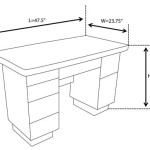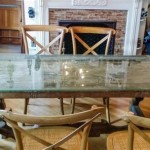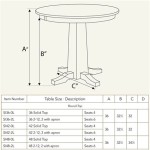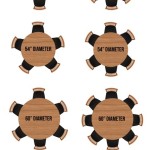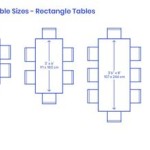The Versatility of a 12-Seat Extendable Dining Table
A 12-seat dining table, particularly one with an extendable feature, represents a significant investment in communal living and entertainment. These tables are designed to accommodate large gatherings, making them ideal for families who frequently host events, or for individuals who simply appreciate having the option to seat a substantial number of guests comfortably. The extendable functionality further enhances their appeal, allowing for flexibility in accommodating different group sizes without requiring a perpetually oversized piece of furniture.
The decision to purchase a 12-seat extendable dining table involves considering several factors, including the available space, the style of the home, the intended use of the table, and the budget. Understanding these aspects is crucial for selecting a table that not only meets practical needs but also complements the overall aesthetic of the dining area.
Space Considerations for a Large Dining Table
The primary constraint when considering a 12-seat dining table is the amount of space available. Before making any purchases, accurate measurements of the dining area are essential. This includes not only the length and width of the room but also accounting for walkways and the placement of other furniture. A general rule of thumb is to allow at least 36 inches between the edge of the table and any walls or obstructions to ensure comfortable movement around the table.
When extended, a 12-seat dining table can occupy a considerable footprint. It is imperative to simulate the extended configuration within the dining space to confirm that it does not impede traffic flow or make the room feel cramped. Consider using masking tape to mark the dimensions of the extended table on the floor, allowing for a visual representation of the space it will occupy. This simulation allows for adjustments in placement and a realistic assessment of the table's impact on the room's functionality.
Furthermore, the shape of the table can influence its space efficiency. Rectangular tables tend to be the most common configuration for 12-seat dining tables, but oval or boat-shaped tables can sometimes offer a more streamlined appearance and slightly improve maneuverability around the table. Round tables, while less common for seating this many people, can foster a more intimate and conversational atmosphere, but they generally require significantly more floor space.
Beyond the table itself, the chairs also contribute to the overall space requirements. The width and depth of the chairs, as well as the space needed to pull them out from the table, should be factored into the calculations. Armchairs, while offering enhanced comfort, typically require more space than armless chairs. Consider stackable or foldable chairs for situations where seating is only needed occasionally, allowing them to be stored away when not in use.
Materials and Styles: Matching the Table to the Home Decor
The material and style of a 12-seat extendable dining table should align with the existing décor of the home. The table should complement the color schemes, architectural details, and overall aesthetic of the dining area. A wide array of materials is available, each offering distinct characteristics in terms of appearance, durability, and maintenance requirements.
Solid wood is a popular choice for dining tables, prized for its natural beauty, strength, and longevity. Different types of wood, such as oak, maple, walnut, and cherry, offer varying grain patterns and color tones. Oak is known for its durability and prominent grain, while walnut offers a richer, darker color and a more refined appearance. Solid wood tables can be stained or painted to match any color scheme, providing versatility in design.
Veneered wood offers a more affordable alternative to solid wood, while still providing a similar aesthetic. Veneers consist of a thin layer of wood adhered to a core material, such as plywood or MDF (medium-density fiberboard). Veneered tables can offer intricate designs and patterns that would be difficult or costly to achieve with solid wood. However, they may not be as durable as solid wood and can be susceptible to damage if the veneer is chipped or scratched.
Metal tables, often featuring steel or aluminum frames, offer a modern and industrial aesthetic. They are typically very durable and easy to maintain. Metal tables can be combined with wooden or glass tabletops to create a more visually interesting and versatile design. Consider the finish of the metal, as brushed or matte finishes tend to be more resistant to fingerprints and scratches than polished finishes.
Glass tabletops offer a sleek and contemporary look. They can make a room feel more open and airy, as they allow light to pass through. Tempered glass is the preferred option for dining tables, as it is more resistant to breakage than ordinary glass. Glass tables can be paired with wooden or metal bases, allowing for a variety of design combinations. However, glass tabletops can be prone to fingerprints and smudges, requiring frequent cleaning.
The style of the table should also complement the overall aesthetic of the home. Traditional dining tables often feature ornate carvings, turned legs, and rich wood finishes. Modern dining tables tend to have clean lines, minimalist designs, and simpler materials. Contemporary styles often incorporate a mix of materials, such as wood, metal, and glass, creating a unique and eclectic look.
Extension Mechanisms: Functionality and Ease of Use
The extension mechanism is a critical aspect of a 12-seat extendable dining table. The mechanism should be robust, reliable, and easy to operate. Several different types of extension mechanisms are available, each with its own advantages and disadvantages.
Butterfly leaf extensions are a common type, where a leaf is hinged and folds out from beneath the tabletop. This type of extension is convenient because the leaf is self-contained and does not require separate storage. However, butterfly leaf extensions may not provide as much additional seating capacity as other types.
Drop-in leaf extensions involve separate leaves that are inserted into the center of the table when expanded. These leaves are typically stored separately, which may require dedicated storage space. However, drop-in leaf extensions can provide a significant increase in seating capacity, making them well-suited for larger gatherings.
Self-storing leaf extensions are similar to drop-in leaf extensions, but they are stored within the table itself, often in a compartment beneath the tabletop. This eliminates the need for separate storage space, making them a convenient option for those with limited storage. However, the self-storing mechanism can sometimes add to the weight and complexity of the table.
Gear-driven extensions utilize a geared mechanism to smoothly and evenly extend the table. These mechanisms are often very robust and reliable, allowing for easy operation, even with heavy tabletops. Gear-driven extensions are typically found in higher-end dining tables and are known for their precision and durability.
Regardless of the type of extension mechanism, it is important to test its functionality before purchasing the table. The mechanism should operate smoothly and easily, without requiring excessive force. The extended leaves should fit snugly and securely, without any gaps or unevenness. The locking mechanisms, if any, should engage and disengage easily and securely.
The weight of the table is also a factor to consider, especially if it needs to be moved frequently. Tables with extension mechanisms can be heavier than non-extendable tables, so it is important to ensure that the table can be moved comfortably, if necessary. Consider tables with casters or wheels to facilitate easier movement.
Finally, the long-term maintenance of the extension mechanism should be considered. Some mechanisms may require periodic lubrication or adjustment. Ensure that the manufacturer provides clear instructions on how to maintain the mechanism and that replacement parts are readily available, if needed.
Selecting a 12-seat extendable dining table requires careful consideration of space, materials, style, and functionality. By thoroughly evaluating these factors, it is possible to choose a table that will provide years of enjoyment and serve as a focal point for gatherings with family and friends. The extendable feature offers the flexibility to adapt to different occasion sizes, making it a valuable asset for any home.

12 Seater Extending Dining Table Wooden Oak Ceramic

30 Ideas Extendable Dining Table Seats 12 Extendablediningroomtableseats12 Extendabledini Square Tables Seat Large Room
Dakota Extendable Square Dining Table For 8 12 160x160 Cm

12 Seater Extending Dining Table Wooden Oak Ceramic

Mega Extendable Dining Table 12 Seat Large Room

Junior Giant Console Extending Table Transformer Seats 12

John Lewis Calia 8 12 Seater Extending Dining Table Oak

Aston 8 12 Seat Extendable Rectangle Dining Table Oak Cult Furniture

Tasmanian Blackwood Dining Table 12 Seater Set

Oakland Rustic Oak 8 12 Seater Extending Dining Table The Cotswold Company


